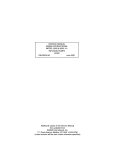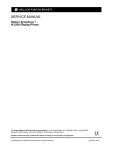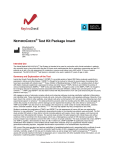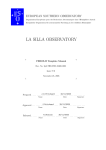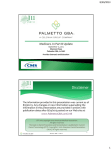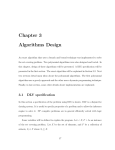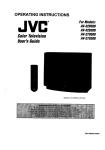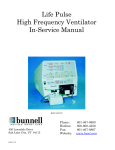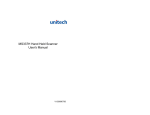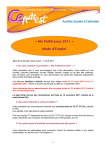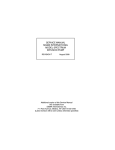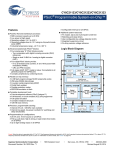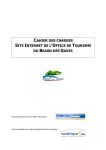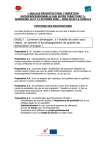Download SIGMA 8000, 8000 Plus and 8002 Plus Infusion Pump Operator`s
Transcript
SIGMA 8000, 8000 Plus and 8002 Plus Infusion Pump Operator’s Manual Sigma International, LLC 711 Park Avenue, Medina, New York 14103 585-798-3901 800-356-3454 585-798-3909 (Fax) PN 44001 (Rev. J) Revised 8/2003 Table of Contents Introduction & Intended Applications Views Loading Sets & Start Up Start-Up with Drug Error Prevention 2 4 6 8 Unloading Sets Important Tips 10 11 Alarm Clearing & User Prompt Displays 13 Option Modes 18 Display Abbreviations Drug Label Library Abbreviations Cleaning & Storing 38 39 42 Servicing 43 Cautions Accessories and SIGMA IV Sets RS232 (Pump to Computer Interface) & Staff Call Flow Sensor (Drop Sensor) Specifications 44 48 50 50 52 Limited Warranty 57 1 Rev.J Introduction & Intended Applications INTRODUCTION: This manual provides instruction for all Sigma 8000 infusion pumps: the 8000, 8000 Plus and 8002 Plus (all referred to as the SIGMA 8000). INTENDED APPLICATIONS: The SIGMA 8000 is intended for the following intravenous and epidural applications; 1. Large and small volume parenterals 2. Neonatal 3. Homecare 4. Epidural Infusions 5. Blood Product Infusions STANDARD IV SET USE: The SIGMA 8000 uses standard gravity IV sets. The principle advantages of standard sets over “captive” sets are; 1. Lowest possible cost. 2. No need to change IV sets when patients move from one hospital area to another. 3. Maximum IV set selection, including needleless. Each SIGMA 8000 is calibrated to use a single brand of standard IV set (either Abbott, Baxter, or B. Braun McGaw*). Unlike other standard set pumps, which cannot be recalibrated, the SIGMA 8000 can be recalibrated to accommodate new IV set suppliers in the future. Since the SIGMA 8000 is designed to use an IV set with a specific inner diameter and elasticity, it will not operate safely and effectively with large diameter blood sets, small diameter micro-bore sets, or stiff nitroglycerin sets. However, special SIGMA 8000 sets are available for blood, lipid and nitroglycerin infusions. These sets utilize a pump insert that is made from standard Abbott, Baxter, or B. Braun McGaw IV tubing. The SIGMA 8000 maintains ±5% flow rate accuracy while using a single tubing section for 72 hours (see “Specifications” for accuracy claims involving rates below 1.9 ml/hr). 2 Rev.J SET BASED ANTI-FREE FLOW PROTECTION: The SIGMA 8000 requires the IV set’s roller clamp be loaded into the pump and it locks the set in the pump preventing set removal until the roller clamp is closed. This system prevents accidental free flow. SIMPLE OPERATION: The SIGMA 8000 is very easy to use. Simply follow the user prompts. OPTION MODES: All the SIMGA 8000’s special capabilities are accessed by means of its OPTION MODES which are listed on the left side of the pump. CONCLUSION: Thank you for taking the time to learn how to operate the SIGMA 8000. The SIGMA 8000 is a safe, reliable, time saving device, that will serve you for many years. *Abbott, Baxter, and B. Braun McGaw are registered trademarks. Contact SIGMA for a complete list of compatible IV sets. 3 Rev.J Views FRONT VIEW – 8000 Single Channel 4 Rev.J REAR VIEW – 8000 Single Channel 5 Rev.J Loading Sets & Start Up SUMMARY: 1. 2. 3. 4. 5. 6. 7. Mount the pump to an IV pole. Plug the pump in. Using compatible IV sets, prime the set and close the roller clamp. Be sure the drug, concentration and volume are as prescribed. Load the IV set (obtain two beeps at ↑ occlusion loading, at lever opening, and at ↓ occlusion loading). Shut the lever and open the roller clamp. Check for no drop flow. Set RATE, VOLUME LIMIT and push RUN. Confirm all pump values are proper and confirm the drop rate approximates the mL/hr rate. 1. Mount the pump to a standard IV pole holding the pump by its handle. Do not hold the pump at its bottom or the pump may mount improperly. 2. Plug the pump into a grounded, hospital-grade AC receptacle. Whenever possible, plug the pump in to maintain full battery charge. 3. Use only the compatible IV sets specified on top of the pump (or flow rate errors result). Contact SIGMA for compatible set lists. 4. Prior to priming the IV set, position the roller clamp so that it can be loaded into the CLAMP HOLDER. Prime the IV set using standard gravity procedure and shut the roller clamp. Be sure the IV container contains the prescribed fluid or drug, drug concentration and volume. 5. Load the closed roller clamp into the CLAMP HOLDER. This turns the pump on, causes 8’s to display, unlocks the lever for 10 seconds and allows the lever to be opened. Characters other than 8’s indicate a display failure. Discontinue pump use and have the pump serviced whenever unusual displays are observed. 6. Load the IV set into the UPSTREAM OCCLUSION/AIR SENSOR (↑ OCC) and then let go of the set. The tubing must snap into the sensor’s two white “teeth”. Two audio beeps occur to indicate the set is properly loaded. 7. After the ↑ OCC sensor is loaded, the LEVER unlocks for 10 seconds. If the LEVER is not opened within 10 seconds, push the OPEN key to 6 Rev.J unlock it. 8. Using one hand only, open the LEVER, keeping it fully opened until the IV set is loaded into the DOWNSTREAM OCCLUSION (↓ OCC) sensor. Two beeps indicate the LEVER is in the proper full open position. Conversely, a raspberry alarm indicates the LEVER is not fully open – which will require the ↓ OCC sensor to be reloaded. 9. Using one hand only and without touching the LEVER, load the set into the ↓ OCC sensor. Two beeps indicate proper set loading. The set should be taut in the pumping channel. Do not push the tubing up. It is important not to over-stretch the tubing while loading the set into the pump or its sensors. 10. Shut the lever to lock the IV set channel. Confirm no tubing is looping out of the pump channel (or free flow can result). 11. Open the roller clamp and all other clamps (center the roller wheel on the OPEN roller sensor). Confirm no drop flow. Immediately discontinue pump use and have the pump serviced if flow is observed when the pump is stopped with the roller clamp opened. 12. Set the RATE (ml/hr) by using the numeric keys. 13. Set the VOLUME LIMIT (in ml). To avoid air entering the IV set, the volume limit should not exceed the IV container’s volume. 14. Push RUN to start the infusion. Confirm all values are correct. After each pump start and after all rate changes, confirm the drop rate approximates the pump’s mL/hr RATE (if they do not correspond, discontinue pump use and send the pump for service). A scrolling RATE display indicates the pump is infusing. 15. To titrate flow rates without stopping the pump, push the RATE key, select a new rate and push ENTER. The rate will not change until ENTER is pushed (push clear to erase a mistaken entry). 7 Rev.J Start-Up with Drug Error Prevention (Optional – not available on all models) SUMMARY – DEP START-UP: 1. 2. Prime and load the IV set. Open the roller clamp. DRUG LABL / YES? NO? – Answer YES if infusing a drug or NO if no drug label is required. (NOTE: If the DRUG LABL question does not appear, turn it on by selecting OPTION 99). ENTR DRUG – Push the desired alpha key, scroll to the drug name, and push YES. Select the desired concentration. Enter all parameters asked for and push RUN. Use OPTION 99 to erase an errant drug mode entry. 3. 4. 5. 6. NOTE: - DEP pumps include customized Drug Libraries that insure all drugs are infused within safe dose rate limits. Drug Error Prevention (DEP) operates only in Primary (mL/hr) and Dose Modes. 1. Follow standard START-UP steps 1-11. In the following example, Dopamine is used and the pump’s Drug Library has been programmed with two Dopamine concentrations. 2. DRUG LABL/YES? NO? displays. Push YES (to reverse a YES decision, simply push NO). 3. ENTR DRUG displays. Push the DEF key once to pull up the D drugs. Use the CLEAR/NO/↓ key to scroll to Dopamine (to reverse an errant drug entry, simply push another alpha key). 4. DOPAMINE/YES? OR ↓ displays. Push YES. 5. Since Dopamine is available in two concentrations (1.6 mg/ml and 800 ug/ml), DRUG 1 of 2 /DOPAMINE/1.6mgml/DOSE ugkm (mcg/kg/min)/YES? NO? displays. Push YES to enter the 1.6 mgml concentration. 8 Rev.J 6. SET DOSE / 0 ugkm displays. Enter a dose rate. - - The exceedable Soft Limits for Dopamine are 3-50 ugkm. If 51 ugkm were entered DOSE HIGH/DOSE LIMIT/50 ugkm/OVER RIDE/DOSE LIMIT/50 ugkm/YES? NO? displays. Push YES to enter 51 ugkm. The pump will infuse with an override message displayed (MAX DOSE/OVER RIDE). The unexceedable Hard Limits for Dopamine are 1-75 ugkm. If 76 ugkm were entered, it would not be accepted and DOSE HIGH/DOSE LIMIT/50 ugkm/SET DOSE/0 ugkm displays. 7. Enter all other values the display asks for and push RUN to start the infusion. 8. To titrate a dose rate without stopping the pump, push ENTER, select the new dose rate and push ENTER again. Drug Label Mode 1. Drug labeling works in all modes of the pump. 2. The Drug Label Mode applies to drugs and fluids where no rate limits have been set up in the pump’s Drug Library. 3. To label a drug or fluid, Push YES when DRUG LABL/YES? NO? Displays and select the drug using the keypad. The drug name and LABL ONLY displays. 4. Use OPTION 99 to erase an errant drug label entry. 9 Rev.J Unloading Sets SUMMARY: 1. 2. 3. 4. With power on, shut the roller clamp. Open the LEVER. Pull the set out from the bottom of the pump towards the top. Shut the LEVER and turn the pump off. 1. With power on and the roller clamp loaded, shut the roller clamp. The pump will stop automatically and the LEVER will unlock for 10 seconds. If the LEVER is not opened within 10 seconds, push the OPEN key to unlock it. 2. Open the LEVER fully. If the LEVER will not open and LEV JAMD/ PUSH LEV/PUSH OPEN displays, push the LEVER in and push the OPEN key to release and open the LEVER. 3. To unload the IV set, hold the set below the LEVER and pull it forward, up and out. Trying to unload the IV set by using the roller clamp or upstream tubing is difficult. 4. After set removal, shut the LEVER and turn the pump off (or reload the IV set, if desired). 10 Rev.J Important Tips SUMMARY: 1. Follow all prompts. 2. No pumped on tubing in sensors. 3. OPT 99 clears all values. 4. Have Biomed check dropped pumps before reuse reuse. 1. Follow prompts during IV set loading and to solve problems. 2. To avoid nuisance alarms: - Use only compatible IV sets (see the top of the pump). Do not load previously pumped-on tubing in front of upstream or downstream occlusion sensors. Keep the roller clamp on the same section of the IV set. Keep the IV set channel clean and dry. Fill the drip chamber halfway. Remove air from IV bags and Y-sites. Invert (do not shake) bags when mixing solutions. Warm IV solutions to room temperature before use. Note: The latter four points avoid microbubble creation. 3. If the roller clamp must be moved, the set must be clamped shut first. 4. To clear single parameters, push STOP, push the desired key and push CLEAR. 5. For six hours after turn off, the pump remembers all values entered. Thereafter all values reset to zero except for; all biomedical entries, all programming mode entries, the audio alarm level, and the occlusion alarm level. 6. To clear all parameter values, enter OPTION 99 This will erase all entered data except for; occlusion pressure levels, audio alarm level, program modes and biomedical mode entries. To clear all program modes, enter OPTION 95. 11 Rev.J 7. To silence the audio alarm for 2 minutes, push the silence key. 8. To check patency, push STOP, close the roller clamp, open the LEVER fully, slowly open the roller clamp and check patency (gravity flow indicates the IV line and catheter are patent). SHUT CLMP will alarm and display. To restart the pump, shut the roller clamp, reload the IV set in the downstream occlusion sensor, shut the LEVER, open the roller clamp, and push RUN. Note: The IV set does not have to be removed from the entire pump, only from the ↓ OCC sensor. 9. Infiltrations cannot be detected by the pump. They must be observed and minimized by operators. 10. Dropped/damaged pumps and pumps with unusual displays must be checked by service personnel before being placed back in use. Otherwise serious patient injury may result. 12 Rev.J Alarm Clearing & User Prompt Displays * BATT LOW: < 30 minutes of battery power remains. Plug the pump in. * BATT CHRG: E.../...F. The slash indicates the approximate amount of battery charge remaining. E (empty) F (full). * BATT ON: The pump is running on battery. The lit plug symbol denotes AC outlet operation. * CHEK CLMP: Move the roller clamp to either the full open or closed position. * CLR AIR/CLR ↑ OCC/PUSH RUN: Note: The upstream sensor detects both air-in-line and upstream occlusions. The user must determine which problem is causing the alarm. 1. LARGE BUBBLES: - Push RUN. Each RUN key actuation advances 0.1ml of fluid. The pump will remain running when the air bubble moves below the air sensor. - Follow policy for removal of air 2. MICROBUBBLES: - Remove the IV set from the UPSTREAM SENSOR. - Tap the tubing, driving all microbubbles upstream. - Reload the IV set into the UPSTREAM SENSOR. - Push RUN. - If nuisance alarms persist, the air/upstream occlusion sensor may be turned off by using a flow sensor (drop sensor). Note that the flow sensor will not fit most drip chambers on blood sets. 3. ↑ OCCLUSION: - Eliminate the cause of the upstream occlusion. - Push RUN. Note: Repeated pushes of RUN without eliminating the cause of the upstream occulsion will eventually prevent the RUN key from restarting the pump. If this happens, eliminate the occlusion cause, 13 Rev.J unload and reload the set from the ↑ occ sensor, and push RUN. *CLR ↑ OCC/EMPT BOTT: The flow sensor is not detecting drops. Correct the problem and push RUN. *CLR ↓ OCC: Eliminate the cause of the downstream occlusion (positional IV, closed clamp, kinked tubing, clogged filter or clotted catheter). The pump restarts automatically. * DOSE COMP/RATE KVO/PUSH STOP: The Dose is complete (see INF COMP/RATE KVO/PUSH STOP). * DOSE LMIT: A dose rate limit for the drug in use has been exceeded. * DRUG 1 OF 2: Select the desired drug concentration * ERR: ERROR - The selected key value exceeds the allowable limit. * FIX ##: “Fix” code numbers indicate pump malfunctions or improper set unloading. Most fix codes may be corrected by: - Unloading the IV set, checking the pump channel for cut or torn tubing (remove it), push OFF, and push ON. Have the pump serviced if the alarm continues. * FLOW SNSR: Plug a FLOW SENSOR into the connector on the back of the pump and position the sensor properly on the IV set’s drip chamber (halfway between the drop orifice and the fluid level and turn its opening away from bright light). Then push RUN. * HIGH (LOW) RATE: The pump was momentarily running at other than the rate selected. If this alarm continues after pushing RUN, discontinue pump use and have the pump serviced. * HIGH TEMP: The internal pump temperature is above 150°F. Allow the pump temperature to return to below 85°F before subsequent operation. This alarm will reset when the temperature goes below 150°F. * INF COMP/RATE KVO/PUSH STOP: INFUSION COMPLETE – The volume to be infused has been delivered. Push STOP to halt the KVO rate, set a new VOL. LIMIT, and push RUN (container overfill accounts for unexpected fluid residuals). Be sure to set the VOL. LIMIT to the value slightly under the volume of the IV container (to prevent air from entering the IV set) 14 Rev.J * IN STOP/PUSH RUN: The pump is stopped. Push RUN to start the infusion. * KEY LOCK: All keys are locked. Key settings can be read but not changed. To unlock keys, push OPTIONS 11. * LABL ONLY: No dose rate limits are associated with the label being displayed. * LEV JAMD: The LEVER is jammed. Push the LEVER in, then push the OPEN key. * LOAD ****: Load the IV set or roller clamp into the area of the pump being indicated. Prime the set prior to loading. * MAX DOSE: The maximum allowable dose rate is displayed. * MIN DOSE: The minimum allowable dose rate is displayed. * MODE CLRD: The existing mode has been cleared. * LOW TEMP: The internal pump temperature is below 40°F. Allow the pump to reach a minimum of 65°F before subsequent operation. This alarm will reset when the temperature goes above 40°F. * OPEN CLMP: Open the roller clamp wheel. * OPEN CLMP/OR/PUSH OPEN: Open the roller clamp’s wheel, or push the OPEN key to open the LEVER and unload the IV set. * OPEN LEV: Open the LEVER to load or unload the IV set. * OPEN LEV/FULLY: Open the lever fully ( two beeps will occur). A raspberry alarm sounds if the LEVER is not open fully. * OPEN LEV/OR/OPEN CLMP: Open the lever to unload the IV set or open the roller clamp. * OVER RIDE: 1) The existing soft rate limit may be exceeded by pushing the YES key. 2) During RUN this display indicates the pump is infusing in an override condition. * PLUG IN: The pump’s battery is depleted. Plug the pump in. * PM DUE :Preventative Maintenance is due. Send the pump to Biomed. 15 Rev.J * PRI FLOW: The Flow Sensor has detected drops in the primary drip chamber while the pump is infusing in the Piggyback Mode. Correct the problem by preventing primary line flow while piggyback volume remains. * PROG COMP/RATE KVO/PUSH STOP: The ramping/tapering program is complete. Push STOP to halt the KVO rate. Turn the pump off or PUSH RUN to restart the program from RT 1, VL 1 (step 1). * PUSH RUN: The pump is in stop. Push RUN to resume the infusion. * RATE LMIT: A RATE LIMIT for the fluid or drug in use has been exceeded. *RELOAD/SET INTO/↓ ↓OCC: Note: The lever automatically unlocks for 10 seconds after a RELOAD SET display. After 10 seconds, push OPEN to unlock the lever. One of the following conditions occurred; - Tubing is not loaded correctly into the downstream occlusion sensor (no 2 beeps). - The lever was not opened fully during the downstream loading process (no 2 beeps). - Tubing was overly stretched downward in the pumping channel as the lever was closed. - Pumped on tubing is loaded in the downstream occlusion sensor. - The IV set was left loaded in the turned off pump for more than 6 hours. After reloading, do not push the set up in the pumping channel. Confirm tubing is not visible or looped out of the peristaltic pump area. *RMVE TUBE: Load the roller clamp and open the lever to remove the set from the pump. * SET ****: Enter the requested parameter. *SHUT CLMP: Shut the roller clamp or free flow may result. * SHUT LEV: Shut the LEVER completely. * TIME OUT: The pump is in a program mode and has been stopped or turned off for 60 minutes or longer. The pump has recycled to the first rate and volume step. 16 Rev.J * YES or ↓: Push YES to enter the displayed drug or NO (↓) to scroll through the list of drugs with the same first letter. 17 Rev.J Option Modes SUMMARY: 1. 2. 3. 4. 5. Push STOP. Push the OPTIONS key. Select the OPTION number (see left side label). Push ENTER. Enter all required parameters and push RUN. 1. Push STOP 2. Push the OPTIONS key. 3. Select the desired OPTION No. (see the next page) 4. Push Enter. 5. Enter all parameter values requested. Push ENTER after each entry. The next prompt will then appear. The last prompt is PUSH RUN. 6. To review all entries, repeatedly push ENTER. 7. To correct a mistaken entry, push CLEAR. To clear an entire option mode, push OPTIONS and enter the option number. Push CLEAR when the option number displays. The pump must be in stop to clear any entry or an entire option. 8. To access other OPTION modes before starting the pump, repeat steps 1-5. 9. Note that NA (not available) displays when an operator selects an OPTION NO. that is not in the pump’s program selection. 18 Rev.J Options List: No. 10 11 12 20 21 *30 *35 40 41 42 43 44 50 51 52 53 54 55 56 57 *60 *61 *62 *63 *64 70 71 72 Option Alarm Tone Loudness Adjustment Keylock Return to Primary Mode Piggyback-time (min.) and vol. limit Piggyback-rate and vol. limit Time-primary time (hrs.) and volume limit (not available) Bolus Mode (not available) Dose-units/hr (un/h) Dose-units/kg/min (unkm) Dose-units/kg/hr (unkh) Dose-milliunits/min (mu/m) Dose-grams/hr (g/h) Dose-mcg/kg/min (ugkm) Dose-mcg/kg/hr (ugkh) Dose-mcg/min (ug/m) Dose-mcg/hr (ug/h) Dose-mg/kg/min (mgkm) Dose-mg/kg/hr (mgkh) Dose-mg/min (mg/m) Dose-mg/hr (mg/h) Programming-Automatic (21 steps) Programming-Automatic (Opt. 60 or 62, taper steps only) Programming-Automatic (custom ramps) Programming-Manual (version 1) Programming-Manual (version 2) Occlusion Pressure (psi) Occlusion Pressure (mmHg) Occlusion Pressure - Alternating Pressure Trending w/Rate 73 Occlusion Pressure - 30 second Pressure Trending **80 Drug Label **81 Clear Drug Label *90 Delayed Start *95 Clear all Program Modes 99 Clear all 6 hour Memory Settings * Not available on all models ** Available for Plus models only 19 Rev.J Options 10, 11, 12 OPT. NO. 10 OPTION NAME Alarm Tone Loudness Adjustment 20 11 Keylock 12 Return To Primary Mode INSTRUCTIONS Stop the pump. Push OPTIONS. Select 10. Push ENTER. Select 1 (quiet) to 3 (loud) if other than the displayed loudness level is desired Push ENTER. The audio will beep once at the selected level. Push RUN to start the infusion. DISPLAY IN STOP/PUSH RUN SET/OPT CODE OPT 10/ALRM TONE/PUSH ENTR TONE 2/PUSH ENTR TONE 2/PUSH RUN To enter KEYLOCK, push OPTIONS. SET/OPT CODE Select 11. OPT 11/KEY LOCK To leave KEYLOCK, push OPTIONS. SET/OPT CODE Select 11. OPT 11/LOCK OFF Note: The set must be loaded and parameters entered before entering KEYLOCK. All parameters can be read but not changed. The pump cannot be turned off. The infusion can be stopped by closing the roller clamp. Stop the pump. Push OPTIONS. Select 12. Push ENTER. From PIG Mode: From Dose Modes and Programming Modes: IN STOP/PUSH RUN SET/OPT CODE OPT 12/PRIM MODE/PUSH ENTR PRIM MODE/RATE X/ VOLX/PUSH RUN PRIM MODE / SET RATE / RATE 0/ SET VOL / VOL 0 Rev. J Options 20 OPT. NO 20 OPTION NAME 21 PIGGYBACK - TIME (MIN.) AND VOL. LIMIT INSTRUCTIONS DISPLAY Stop the pump. IN STOP/PUSH RUN Push OPTIONS. SET/OPT CODE Select 20. OPT 20/PIG MODE/PUSH ENTR Push ENTER. SET/PIG TIME/0 min Select the piggyback TIME in minutes (from 1-1440 min). For example, select 30 min. Push ENTER. PIG TIME/30 min/PUSH ENTR Select the piggyback VOLUME LIMIT (from 0.19999 ml). For example, select 50 ml. Push ENTER VOL 50/PIG VOL//PUSH ENTR Ensure that the slide clamp on the piggyback line is open, press ENTER OPT 20/PIG MODE/IN STOP/PUSH RUN Open all clamps and push RUN to start the infusion. PIG/RATE XXX/PIG TIME/XXXXMINS alternately display SET/PIG VOL/VOL 0 CHEK/PIG CLMP/PUSH ENTR Or to clear all PIG MODE values push CLEAR when PUSH RUN or OPT 20 displays. Note: The piggyback instructions under OPT. 21 below apply to OPT. 20 also. Rev. J Options 21 OPT. NO OPTION NAME 22 21 PIGGYBACK - RATE AND VOL. LIMIT INSTRUCTIONS Stop the pump. Push OPTIONS. Select 21. Push ENTER. Select the piggyback RATE (from 0.1 to 999 ml/hr). For example, select 100 ml/hr. Push ENTER. Select the piggyback VOLUME LIMIT (from 0.1 to 9999 ml). For example, select50 ml. Push ENTER. Ensure that the slide clamp on the piggyback line is open, press ENTER. Push RUN to start the infusion DISPLAY IN STOP/PUSH RUN SET/OPT CODE OPT 21/PIG MODE/PUSH ENTR SET/PIG RATE/RATE 0 SET/PIG VOL/VOL 0 PIG VOL/VOL 50/PUSH ENTR CHEK/ PIG CLMP/PUSH ENTR OPT 21/PIG MODE/IN STOP/PUSH RUN PIG/RATE 100/PIG/VOL 50 (vol. counts down to 0.) Rev. J Or to clear all PIG MODE values push CLEAR PIG COMP when PUSH RUN or OPT 21 displays. PRI RATE/RATE XXX Note: Use only compatible primary check valve sets and secondary piggyback sets. Attach the piggyback container and set to the upper Y-site of the primary check valve set. Lower the primary container below the secondary container using the hanger provided with the secondary set. Be sure a primary RATE and VOL. LIMIT are entered. If the piggyback volume limit is less than the piggyback container’s volume, residual piggyback medication will run at the primary flow rate once the piggyback volume limit is delivered. Therefore, safe practice dictates that the primary flow rate not be higher than the piggyback flow rate (always follow physicians orders). Assuming the PIG. VOL. LIMIT equals the piggyback container volume, automatic gravity switchover to the primary container will coincide with the pump’s switchover from piggyback to primary settings (4 tones - optional). When using a FLOW SENSOR while piggybacking, place the sensor on the primary container’s drip chamber. If flow is detected in the primary container prior to the completion of the piggyback infusion (Vol. Limit), the display is ”PRI FLOW”. NOTE: OPTIONS 20 & 21 may be used with the 8000 Plus, Plus 8002 Plus “Drug Label ONLY” Feature. Dose Mode Abbreviations 23 Dose Mode Option # 40 41 42 43 44 50 51 52 53 54 55 56 57 Description units / hr units / kg / min units / kg / hr milliunits / min grams / hr micrograms (mcg) / kg / min micrograms (mcg) / kg / hr micrograms (mcg) / min micrograms (mcg) / hr milligrams (mg) / kg / min milligrams (mg) / kg / hr milligrams (mg) / min milligrams (mg) / hr Display Abbreviation un / h unkm unkh mu / m g /h ugkm ugkh ug / m ug / h mgkm mgkh mg / m mg / h NOTE: The 8000 Plus / 8002 Plus Drug Error Prevention Software may be used with the above dose modes (Drug Error Prevention software is not available on all models). Rev. J Options 40, 41, 42, 43, 44 OPT. OPTION NAME INSTRUCTIONS DISPLAY NO Note: For the following OPTIONS 40, 41, 42 and 43, the CONC unit (amount of drug dissolved in the dosage container) may be set from 0.1 to 999,999 units. DOSE MODE Follow the same operating instructions as OPTION 52, except enter units/hr(instead of mcg/min) 40 units/hr (un/h) 24 41 DOSE MODE units/kg/min (unkm) Follow the same operating instructions as OPTION 50, except enter units/kg/min (instead of mcg/kg/min). 42 DOSE MODE units/kg/hr (unkh) Follow the same operating instructions as OPTION 50, except enter units/kg/hr (instead of mcg/kg/min). 43 DOSE MODE milliunits/min (mu/m) Follow the same operating instructions as OPTION 52, except enter milliunits/min (instead of mcg/min). 44 DOSE MODE grams/hr (g/h) Follow the same operating instructions as OPTION 52, except enter grams/hr (instead of mcg/min). Rev. J Options 50 OPT. NO INSTRUCTIONS DOSE MODE mcg/kg/min (ugkm Stop the pump. Push OPTIONS. Select 50. Push ENTER. Select the DOSE in mcg/kg/min (0.1 to 9999 ugkm). For example, select 2.0 ugkm. Push ENTER. Select the amount of drug dissolved in the dosage container (0.1-9999 mg). For example, select 400 mg. Push ENTER. Select the total volume of the dosage container (0.1-9999 ml). For example, select 250 ml. This and the former step establish the dosage “concentration” (i.e. CONC). Push ENTER. Select the patient’s body weight in kg (0.1-999 kg).Note: 1 kg = 2.2 lbs, 1 lb. = 0.454 kg. For example, select 80 kg. Push ENTER. The computed ml/hr rate is displayed Select the VOLUME LIMIT - that portion of the dosage container that is to be infused (0.1-9999 ml). For example, select 250 ml Push ENTER. The computed ml/hr RATE is displayed. Push RUN to start the infusion 25 OPTION NAME 50 DISPLAY IN STOP/PUSH RUN SET/OPT CODE OPT 50/DOSE ugkm/PUSH ENTR SET DOSE/0 ugkm 2.0 ugkm/ PUSH ENTR SET CONC/0 mg 400 mg/PUSH ENTR SET CONC/0 ml 250 ml/PUSH ENTR SET kg/0 kg 80 kg/PUSH ENTR 6.0 ml/hr / DOSE ugkm/SET VOL/ VOL 0 250 VOL/PUSH ENTR OPT 50/2.0 ugkm/6.0 ml/h/IN STOP/ PUSH RUN Note: Rev. J • • If the values entered above are not within the pump’s operating specifications, ERR RATE or ERR ugkm displays. Enter correct value as prompted. • • To change the RATE (ml/h), stop the pump and press the RATE key. Select new rate and the dose will automatically be recalculated. Push RUN. • • To review all dose mode entries, repeatedly push ENTER If the values entered above do not result in a computed RATE (ml/h) or dose within the pump’s allowable range, RATE or DOSE HIGH or LOW will display. Follow prompts to enter new values. To change any dose mode parameter; stop the pump, push ENTER until the parameter appears, select the new value, push ENTER, push RUN. All affected parameters will be recalculated. To clear this option, push CLEAR while either; PUSH RUN or OPT 50 displays. Options 50 (cont’d), 51, 52 OPT. NO OPTION NAME 51 52 DISPLAY DOSE flashes for ten seconds New dose displays alternating with PUSH ENTR. New DOSE is accepted. Infusion starts at new dose and recalculates rate (ml/h). Push ENTER. Note: If ENTER is not pushed to complete the rate change, continuous titration alarm tones alert the operator that a rate change has not occurred. The pump will continue to infuse at the original rate set Infusion starts at new RATE (ml/h) and recalculates dose DOSE MODE - mcg/kg/hr (ugkh) Follow the same operating instructions as OPTION 50, except enter mcg/kg/hr (instead of mcg/kg/min.) OPT 51/DOSE ugkh DOSE MODE - mcg/min (ug/m) Stop the pump. Push OPTIONS. Select 52. Push ENTER. Select the DOSE in mcg/min (0.1-9999 ug/m). For example, select 50.0 ug/m.Push ENTER. Select the amount of drug dissolved in the dosage container (0.1-9999 mg). For example, select 100 mg. Push ENTER. IN STOP/PUSH RUNSET/OPT CODE OPT 52/DOSE ug/m/PUSH ENTR SET DOSE/0 ug/m 50 ug/m/PUSH ENTR 26 50 INSTRUCTIONS To titrate DOSE, push ENTER Select new dose Push ENTER. Note: If ENTER is not pushed to complete the dose change, continuous titration alarm tones alert the operator that a dose change has not occurred. The pump will continue to infuse at the original dose/rate set. To titrate RATE, push RATE Key. Select new RATE DOSE MODE - mcg/kg/min (ugkm TITRATION RATE (ml/h) flashes for ten seconds. New RATE (ml/h) displays alternating with PUSH ENTR. Rev. J SET CONC/0 mg 100 mg/PUSH ENTR SET CONC/0 ml Options 52 (continued) OPT. NO 52 27 OPTION NAME INSTRUCTIONS DOSE MODE mcg/min (ug/m) Select the total volume of the dosage container (0.19999 ml). For example, select 250 ml Push ENTER. Select the VOLUME LIMIT - that portion of the dosage container that is to be infused (0.1-9999 ml). For example, select 250 ml.Push ENTER. The computed ml/hr RATE is displayed.Push RUN to start the infusion DISPLAY 250 ml/PUSH ENTR 7.5 ml/hr/DOSE ug/m/SET VOL/VOL 0250 VOL/PUSH ENTR- OPT 52/50 ug/m/7.5 ml/h/IN STOP/ PUSH RUN For additional tips on; RATE ERR, changing RATE, reviewing all entries, and clearing this option, see “NOTE” under OPTION 50. Rev. J Options 53, 54, 55, 56, 57 OPT. NO OPTION NAME INSTRUCTIONS DISPLAY Follow the same operating instructions as OPTION 52, except enter mcg/hr. (instead of mcg/min). OPT 53/DOSE ug/h 54 DOSE MODE mg/kg/min (mgkm) Follow the same operating instructions as OPTION 50, except enter mg/kg/min(instead of mcg/kg/min). OPT 54/DOSE mgkm 55 DOSE MODE mg/kg/hr (mgkh) Follow the same operating instructions as OPTION 50, except enter mg/kg/hr (instead of mcg/kg/min) OPT 55/DOSE mgkh 56 DOSE MODE mg/min (mg/m) Follow the same operating instructions as OPTION 52, except enter mg/min (instead of mcg/min).- OPT 56/DOSE mg/m- 57 DOSE MODE mg/hr (mg/h) Follow the same operating instructions as OPTION 52, except enter mg/hr (instead of mcg/min). OPT 57/DOSE mg/h 28 53 DOSE MODE mcg/hr (ug/h) Rev. J Example: Option 60 – Auto Program Mode 29 Rev. J Options 60 30 Rev. J OPT. OPTION NAME INSTRUCTIONS DISPLAY NO In AUTOMATIC PROGRAMMING MODE (also Called ‘ramping/tapering’), entry of a single VOLUME LIMIT (ml) and infusion TIME (hrs.) results in the pump computing a 21 step; ramp up (10 steps), MAIN RATE (1 step), and taper down (10 steps) program. The program ends with a PROG COMP (program complete) alarm and KVO rate. The ramp and taper each take10% of total time, leaving 80% of total time for the MAIN RATE. The ramp and taper are broken into 10 steps each, with the first ramp step RATE beginning at 50% of the MAIN RATE. Each succeeding step results in a RATE increase equivalent to 5% of the MAIN RATE. The taper mirrors the ramp, but with descending RATES. See the graph on page29 for a programming example. The pump may be programmed with or without an IV set loaded. Program entries are maintained in permanent memory and may be cleared by: pushing OPTIONS, the desired OPT. number, and then pressing CLEAR, or by using OPTION 95 - Clear all Program Modes. These actions cause a return to primary mode (PRI MODE) If a pump is turned off in the middle of a program and is left off for TIME OUT more than 60 min., it will automatically reset to step 1. If it is turned back on in less than 60 mins, it remains at the step in which it was OPT 60/AUTO PROG/STEP XX/IN turned off. STOP/PUSH RUN PROGRAMMING Stop the pump. IN STOP/PUSH RUN AUTOMATIC Push OPTIONS. SET/OPT CODESelect 60. OPT 60/AUTO PROG/PUSH ENTR60 (21 STEPS) Push ENTER. SET PROG/VOL 0 (Not available on Select the total VOLUME LIMIT in ml. For example, select 2000 ml. VOL 2000/PUSH ENTR all models) Push ENTER SET PROG/0 hrs Select the total infusion TIME in hrs. For example, select 10 hrs. 10 hrs/PUSH ENTR OPT 60/AUTO PROG/STEP1/IN STOP/ Push ENTER PUSH RUN Push RUN to begin the infusion. To review actual RATES and VOL. LIMITS for each individual step, repeatedly push the RATE or VOL. LIMIT keys with pump stopped To exit OPTION 60 and immediately begin the taper steps, simply enter OPTION 61 Options 61, 62 OPT. NO OPTION NAME INSTRUCTIONS DISPLAY • 61 PROGRAMMING AUTOMATIC (Opt. 60 or 62, taper steps only) OPTION 61 allows an immediate taper exit from OPTION 60 or 62. If the program is stopped in the ramp up (steps 1-10), the taper will begin at the corresponding taper down step. If the program is stopped while infusing in the main rate (RT 11), the taper begins at step 12 and ends at step 21. Stop the pump. IN STOP/PUSH RUN Push OPTIONS. SET/OPT CODE Select 61. OPT 61/AUT TAPR/PUSH ENTR Push RUN to start the pump and begin the taper steps only. • OPTION 62 allows entry of customized ramp and taper steps. The operator enters; a total VOLUME LIMIT, a total infusion TIME, ramp time, and taper time. • The pump computes 10 appropriate RAMP rates and volume limits (which start at 50% of the MAIN RATE and ramp up in increments equivalent to 5% of the MAIN RATE). 31 • The 10 RAMP steps are followed by step11 - the MAIN RATE and MAIN VOLUME, which is followed by TAPER Rev. J steps 12 through 21 concluding in a PROGRAM COMPLETE alarm and KVO rate. Stop the pump. IN STOP/PUSH RUN Push OPTIONS. SET/OPT CODE Select 62. OPT 62/CUST PROG/PUSH ENTR Push ENTER. SET PROG/VOL 0 Select the total VOLUME LIMIT in ml. For example, select 2000 ml. VOL 2000/PUSH ENTR Push ENTER. SET PROG/0 hrs Select the total infusion TIME in hrs. For example, select 10 hrs 10 hrs/PUSH ENTR Push ENTER SET RAMP/RAMP UP/0 hrs Select the RAMP TIME in hrs. For example, select 0.5 hrs (30 0.5 hrs/RAMP UP/PUSH ENTR mins.). Push ENTER. SET TAPR/TAPR DOWN/0 hrs Select the TAPER TIME in hrs. For example, select 0.5 hrs. (30 0.5 hrs/TAPR DOWN/PUSH ENTR mins.). Push ENTER OPT 62/CUSTPROG/STEP1/PUSH RUN • Push RUN to begin the infusion. Program entries are maintained in permanent memory and can only be cleared by: pushing the OPTIONS key and entering the option number, followed by pushing CLEAR, or by using OPTION 95-Clear all Program Modes. These actions cause a return to primary mode (PRI MODE). 62 PROGRAMMING AUTOMATIC (CUSTOM RAMP) (Not available on all models) Options 63, 64, 70 OPT. NO OPTION NAME INSTRUCTIONS DISPLAY 32 OPTIONS 63 and 64 allow entry and storage in the pump’s permanent memory of two different ramping/tapering programs. OPTIONS 63 and 64 require each step’s RATE and VOLUME LIMIT to be entered individually. Stop the pump. IN STOP/PUSH RUN Push OPTIONS. SET/OPT CODE Select 63 (or 64). OPT 63/MANU PROG/PUSH ENTR Push ENTER. SET RT 1/RT1 0 RT1 50/PUSH ENTR 63 PROGRAMMING Select the step 1 infusion RATE. For example, select 50 ml/hr. Push ENTER. SET VL1/VL1 0 MANUAL Select the step 1 VOLUME LIMIT. For example, select 10 ml. VL1 10/PUSH ENTR 64 (Versions 1 & 2) Eleven (11) steps are available. Enter the desired values for each step OPT 63 (OR 64)/MANU PROG/ STEP being used. 1/PUSH RUN After values for the desired number of steps (up to 11) have been selected and ENTER pushed, push run to begin the infusion Program entries are maintained in permanent memory and can only be cleared by pushing the OPTIONS key and entering the option number, followed by pushing CLEAR, or by using OPTION 95-Clear all Program Modes. These actions cause a return to Primary Mode (PRI MODE). NOTE: OPTIONS 60-64 may be used with the 8000 Plus, 8002 Plus “Drug Label ONLY “ feature. Stop the pump. IN STOP/PUSH RUN Push OPTIONS. SET/OPT CODE Select 70. The occlusion alarm pressure may be adjusted from 2 to 15 OPT 70/OCCL psi/PUSH ENTR psi in 1 psi increments (1 psi approximates 50 mmHg). OCCLUSION 70 Push ENTER. (Note: Pumps are factory set to 10 psi-500 mmHg). 10psi PRESSURE (psi) If other than the displayed value is desired, select the new value. For 9psi/PUSH ENTR example 9 psi (450 mmHg). Push ENTER IN STOP/PUSH RUN Push RUN to begin the infusion Rev. J Options 71, 72, 73 OPT. NO OPTION NAME 71 33 72 73 INSTRUCTIONS Stop the pump .Push OPTIONS. Select 71. The occlusion pressure may be adjusted from 100 to 750 mmHg in 50 mmHg increments. Settings other than 50 mmHg increments are rounded off by the pump Push ENTER (Note: Pumps are factory set to10 psi-500 mmHg). If other than the displayed value is desired, select the new value. For example: 450 mmHg (9 psi). Push ENTER ALTERNATING PRESSURE TREND DISPLAY WITH RATE 30 SEC. PRESSURE TREND DISPLAY Push OPTIONS. SET/OPT CODESelect 72. Push ENTER. Turn this display off (or on) by pushing ENTER. DISPLAY IN STOP/PUSH RUN SET/OPT CODE OPT 71/OCCL mmHg/ PUSH ENTR 500 mmHg 450 mmHg/PUSH ENTR IN STOP, PUSH RUN OPT 72/PRES DISP/PUSH ENTR Display ON (or OFF) Rev. J Push OPTIONS. SET/OPT CODE Select 73. OPT 73/PRES DISP/PUSH ENTR Push ENTER Pressure displays for 30 sec PRESSURE TRENDING (Options 72 and 73): -1 to 8 arrows display to represent percentages of full scale; > > > > > > > > 10% of scale 50% of scale 100% of scale (or 25mmHg- whichever is greater) The 8th arrow, i.e. ”full scale”, represents the occlusion pressure limit. For example, if the occlusion pressure limit were 100-mmHg and4 arrows were displayed, the pumping pressure is approximately 50-mmHg (or 50% of full scale). If that same pump went into occlusion alarm, pumping pressure had reached 100 mmHg. The 8th arrow never actually displays. Rather, if the pressure signal rises to that point ”CLR ¯ OCCL” (clear downstream occlusion) displays. Options 80 OPT. NO. 80 OPTION NAME DRUG LABEL (ENABLE/ DISABLE) (Available for Plus models with “label only” software) INSTRUCTIONS DISPLAY Stop the pump. Push OPTIONS. IN STOP / PUSH RUN SET / OPT CODE Select 80. OPT 80 / DRUG LABL / PUSH ENTR Push Enter LABL ON YES/NO or LABL OFF YES/NO Push CLEAR to change the status then push ENTER to select 34 If an infusion is already programmed ………………… Otherwise, once the infusion has been programmed If YES……………………………………………………... If NO………………………………………………………. the Drug Menu shall then be entered DRUG LABL / YES? NO? the Drug Menu shall be entered the pump is ready to run While the Drug Label feature is in use: If the DRUG LABEL has been enabled in Option 80, the pump shall display “DRUG LABL / YES? NO?” after the setup of any infusion has been completed. If the label is not desired, the NO key may be pressed to advance the “IN STOP / PUSH RUN” display. Otherwise, the YES key must be pressed to enter the drug menu from which the desired drug name may be selected and placed in the display. Rev. J The menu shall display the first ‘A’ drug upon entry. The menu shall be designed with an interface similar to that of the telephone. The keys 2-0 shall be utilized with each letter of the alphabet. The first press of the numeric key would initiate a listing of the supported drug names starting with the first letter associated with that key. So in this instance where the first ‘A’ drug is in the display, if the operator is delivering Colloids into the patient, they would push the ‘2’ key two times to bring up the alphabetical listing of the supported ‘C’ drug names and then press CLEAR (NO) to scroll the list until “COLL OIDS” is observed. Enter will select it and the pump shall proceed to the ready-to-run state. If the operator happens to scroll past the drug they want, a single press of the associated numeric key will place them back at the top of the list o f the current letter they are viewing. For example, if the operator is looking for Dobutamine and scrolls past it to Docetaxel, they can just press the ‘3’ again to put them back at Diltzern (the first drug in the ‘D’ list). In another example, if the operator wants to view the ‘N’ drug name and presses the ‘6’ key three times instead of the two putting them in the ‘O’ list, the software shall wrap around to the ‘M’ labels on the fourth press and back to the ‘N’ list on the fifth. If Option 80 is entered and the drug label feature disabled while a mode is currently set up with a drug label attached, the label will be excluded from the running display. Options 80 OPT. NO. OPTION NAME INSTRUCTIONS DISPLAY EDIT: If the operator accidentally enters the wrong label or answered NO to the “DRUG LABL / YES? NO?” prompt when they really meant to press YES, they may press the ‘1’ key on the pump, labeled “EDIT”. 80 35 DRUG LABEL (ENABLE/ DISABLE) (Available for Plus models with “label only” software) If the operator presses the “EDIT” key and the pump is not running, the pump shall display “EDIT LABL / <drug name> / YES? NO?”. If the operator presses YES on the pump keypad, the display shall show the drug name that was incorrectly assigned and the operator may then navigate to the correct one using the method described above. If the operator presses NO at the “EDIT LABL / <drug name> / YES? NO?” display, the pump will revert to the display shown prior to the “EDIT” key press. If the Drug Label feature is not enabled, pressing the “EDIT” key shall do nothing. If the Drug Label feature is enabled the “EDIT” key is pressed while the pump is running, “STOP PUMP / TO SET / DRUG LABL” shall be displayed. Labeling a Piggyback Infusion: If the user has programmed a Piggyback Mode infusion to take place before the main infusion, the pump will allow the user to assign separate Drug Labels to both the Piggyback and Main infusion. Rev. J Options 81, 90 OPT. NO. 81 OPTION NAME CLEAR DRUG LABEL (Available for all Plus models INSTRUCTIONS Stop the pump. Push OPTIONS. Select 81. Push Enter DISPLAY IN STOP / PUSH RUN SET / OPT CODE OPT 81 / CLR LABL / PUSH ENTR LABL CLRD IN STOP / PUSH RUN Using this option to clear the drug label will also clear the Piggyback drug label if one is assigned. 36 Option 90 enables the operator to delay the start of an infusion with or without a KVO rate during the delay period and to delay the KVO alarm once the infusion has completed. Stop the pump. IN STOP / PUSH RUN Push OPTIONS. SET / OPT CODE Select 90. OPT 90 / DLAY STRT / PUSH ENTR Push ENTER. SET / DLAY STRT / 0 hrs Enter the delayed start time in hours. For example, enter 1.5 hrs 1.5 hrs / DLAY STRT / PUSH ENTR(90 mins). 90 DELAYED START (i.e.: “DLAY STRT) Push ENTER. (Not available on all models) KVO ON / YES? NO? If KVO infusion is required during the delay, push (YES) ENTER KVO YES / PUSH ENTR If not required, push NO (CLEAR). NO KVO / PUSH ENTR Push ENTER. DLAY END / KVO ALRM / 0 hrs Rev. J Enter the KVO alarm delay time in hours. For example, enter 0.5 hrs / KVO ALRM / PUSH ENTR 0.5 hrs (30 mins). If the infusion mode is not yet set up, Push ENTER to accept PRI MODE / YES? NO? setting. If the pump is to run in Primary Mode, push YES. PRI YES / PUSH ENTR If not, push NO. NOT PRI / PUSH ENTR Push ENTER to accept the setting NOTE: If a non-running delayed start was selected and the currently installed tubing has been pumped on, the pump motor will now position itself to maintain flow accuracy. DLAY STRT / SET RATE / RATE 0-DLAY If Primary Mode was selected above, (when all set to run) STRT / PRI MODE / IN STOP /PUSH RUN Options 90, 95 &99 OPT. NO. OPTION NAME DELAYED START (i.e.: “DLAY STRT) 90 (Not available on all models) INSTRUCTIONS If Primary Mode was not selected above, -Enter option number for the Option Mode desired to run following the delay. SET / OPT CODE- Go through mode set-up. OPT 60 / AUTO PROG / PUSH ENTR (example, Option 60 entered) If an infusion mode is set up prior to entering this option, that mode will become the delayed mode and you will not be asked during the Delayed Start setup to select a mode. -Push RUN. DLAY STRT / OPT 60 / AUTO PROG /STEP 1 / PUSH RUN If a KVO delay start selected (pump runs at KVO rate 37 If not………………………………………………... Note: Pushing STOP at any time during a delayed start or a KVO alarm delay pauses the timer. To continue the delay, push RUN. 95 99 CLEAR ALL PROGRAM MODES CLEAR ALL 6 hr MEMORY DISPLAY Stop the pump. Push OPTIONS. Select 95. Push ENTER RATE KVO / DLAY STRT / 1.5 hrs / OPT 60 / AUTO PROG DLAY STRT /1.5 hrs / OPT 60 / AUTO PROG IN STOP/PUSH RUNSET/OPT CODEOPT 95/CLR PRGS/PUSH ENTRPRGS CLRD/SET RATE Rev. J Note: Use of this option enables the operator to clear all pump memory, except the following items which must be cleared individually • Keylock • Alarm Volume • Occlusion Pressure Options • Maximum RATE or VOL. LIMIT Settings • Biomedical Mode Entries Programming Modes Stop the pump. IN STOP/PUSH RUN Push OPTIONS. SET/OPT/CODE Select 99. OPT 99/CLR ALL/PUSH ENTR Push ENTER ALL CLR/SET RATE Display Abbreviations Abbreviation ALRM AUTO BATT CHEK Definition Alarm Automatic Battery Check Abbreviation m, min MIN ml mmHg CHRG CLMP CLR, CLRD Charge Clamp Clear, cleared mu OCCL ↑OCC COMP Complete ↓OCC CONC CUST DISP DLYD ENTR ERR FULLY Concentration Custom Display Delayed Enter Error Fully OPT PIG POWR PRES PRI PROG PSI g h, hr, hrs gram(s) hour (s) INF JAMD k, kg KVO LABL LEV LIMT MANU MAX Mg Infusion Jammed kilogram Keep vein open Label Lever Limit Manual Maximum Milligram(s) RE LOAD RE MOVE, RMVE RATE, RT STRT TAPR TEMP TOTL VL VOL ug un 38 Definition minute(s) Minimum milliliter(s) millimeters of mercury milliunit(s) Occlusion Upstream occlusion sensor, upstream occlusion Downstream occlusion sensor, downstream occlusion Option Piggyback Power Pressure Primary Program Pounds per square inch Reload Remove Rate Start Taper Temperature Total Volume Volume microgram(s) unit(s) Rev. J Drug Label Library Abbreviations Default drug label list available in the 8000 Plus and 8002 Plus. In 8000 Plus / 8002 Plus Drug Error Prevention software, this list can be customized by each facility. Drug Abciximab Acyclovir Aldesleukin Alfentanil Alprostadil Alteplase (rt – PA) Amikacin Aminocaproic Acid Aminophylline Amiodarone Amphotericin B Ampicillinsulbactum Amrione Analgesic Antibiotic Anticonvulsant Antidote Antiviral Abbreviation Abci xima Acyc lovi Alde sleu Alfe ntan Alpr osta Alte plse Drug Cefotetan Cefoxitin Ceftazidime Ceftizoxime Ceftriaxone Cefuroxime Abbreviation Cefo teta Cefo xiti Ceft azid Ceft izox Ceft riax Cefu roxi Amik acin Amin ocap Central Line Chemotherapy Cent ral Chem o Amin Amio Amph Ampi Cimetidine Ciprofloxacin Cisatracurium Cisplatin Cime tidi Cipr o Cisa trac Cisp lati Amri Anal Anti Anti Anti Anti Clad Clin Coll Cotr Crys Cycl Aztr eona Bact rim Bleo myci Bloo d Bret yliu Bume tani Calc gluc Cladribine Clindamycin Colloids Cotrimoxazole Crystalloid Cyclophosphami de Cyclosporine Cytarabine Diltiazem Diuretic Dexmedetomidin e Dobutamine Docetaxel Dopamine Doxil Doxorubicin Drotrecogin Enalapril Argatroban Arterial Ascorbic Acid Atracurium Azithromycin Arga trob Arte rial Asco rbic Atra curi Azit hrom Aztreonam Bactrim Bleomycin Blood Products Bretylium Bumetanide Calcium Gluconate Carboplatin Carmustine Cefazolin Cefepime Cefoperazone Cefotaxime Carb Carm Cefa Cefe Cefo Cefo Epidural Epinephrine Eptifibatide Erythromycin Esmolol Etomidate ophy daro oter sulb one gesi biot conv dote vira opla usti zoli pime pera taxi 39 ribi damy oids imox tall opho Cycl ospo Cyta rabi Dilt iaze Diur etic Dexm edet Dobu tami Doce taxe Dopa mine Doxi l Doxo rubi Drot reco Enal apri Epid ural Epin ephr Epti fiba Eryt hrom Esmo lol Etom idat Rev. J Drug Etoposide Famotidine Femoral Fenoldopam Fentanyl Abbreviation Etop osid Famo tidi Femo ral Feno ldop Fent anyl Filg rast Fluc onaz Flud arab Flum azen Fosp heny Drug Meperedine Mesna Methohexital Methotrexate Methylprednisolo ne Metocloprimide Metoprolol Metronidazole Midazolam Milrinone Filgrastim Fluconazole Fludarabine Flumazenil Fosphenytoin Meto clop Meto prol Metr onid Mida zola Milr inon Furosemide 5FU Gemcitabine Gentamicin Heparin Furo semi Five FU Gemc itab Gent amic Hep arin Mivacurium Morphine Muscle Relaxant Nafcillin Naloxone Miva Morp Musc Nafc Nalo Hetastarch Hydrocortisone Sod. Succinate Hydromophone Ibutilide Idarubicin Ifosfamide Imipenem Cilastatin Infliximab Inodilator Insulin Heta star Hydr ocor Nesiritide Nicardipine Nesi riti Nica rdip Hydr Ibut Idar Ifos Imip Nitroglycerin Nitroprusside Norepinephrine Octreotide Ofloxacin Nitr ogly Nitr opru Nore pine Octr eoti Oflo xaci Infl ixim Ino dila Insu lin Ondansetron Oxacillin Oxytocin Onda nset Oxac illi Oxyt ocin Irinotecan Isoproterenol Itraconazole Ivig Jugular Ketamine Labetalol Leucovorin Lidocaine Linezolid Lipids Lorazepam Iron otec Isop rote Itra cona Ivig Jugu lar Keta mine Labe talo Leuc ovor Lido cain Line zoli Lip ids Lora zepa Pacl itax Pami dron Panc uron Pant opra Peni cill Pent obar Peri pher Phen ylep Phen ytoi Phyt onad PICC Pipe bact Levofloxicin Magnesium Infusion Mannitol Levo flox Magn esiu Paclitaxel Pamidronate Pancuronium Pantoprazole Penicillin Pentobarbital Peripheral Phenylephrine Phenytoin Phytonadione PICC Piperacillinbactam Piperacillin Plicamycin Potassium Infusion Pota sium omop ilid ubic fami Cila Mann itol 40 Abbreviation Mepe redi Mes na Meth ohex Meth otre Meth pred curi phin Rela illi xone Pipe raci Plic amyc Rev. J Drug Potassium Phosphate Procainamide Propofol Abbreviation Pota phos Prostaglandin E1 Quinolone Pros tagl Quin olon Ranitidine Remicade Rituximab Rocu roni Sedative Sodium Chloride 3% Sodium Phosphate Steroid Streptokinase Subclavian Subcutaneous Sufentanil Synercid Tenecteplase Teniposide Terbutaline Theophylline Ticar-clavulanate Tirofiban Tobramycin Topotecan TPN Trastuzumab Trovafloxacin Umbilical Arterial Catheter Umbilical Venous Catheter Urokinase Vancomycin Vasopressin Vecuronium Venofer Verapamil Vincristine Zoledronic Acid Rani tidi Remi cade Ritu xima Rocuronium Seda tive NaCl 3% Drug Abbreviation Proc aina Prop ofol Sodi phos Ster oid Stre ptok Sub clav Sub cuta Sufe ntan Syne rcid Tene ctep Teni posi Terb utal Theo phyl Tica clav Tiro fiba Tobr amyc Topo teca TPN Tras tuzu Trov aflo UAC UVC Urok inas Vanc omyc Vaso pres Vecu roni Veno fer Vera pami Vinc rist Zole dron 41 Rev. J Cleaning & Storing CLEANING: 1. Turn the unit off and disconnect the power plug from the AC Power source before cleaning. 2. Clean exterior surfaces with the pump in an upright position. Apply cleaners with a dampened cloth per the manufacturers’ instruction and dilution ratios. Disinfectants should remain on the pump surface in even, but not dripping film for the manufacturers’ recommended contact time. Wipe dry or air-dry after completion of the contact time period before reusing the pump. Dispose of all cleaning/disinfectant materials per federal, state, and local regulations for infectious waste disposal. 3. All elements in the IV SET CHANNEL should be cleaned on a routine basis with lint free, foam tipped swab (Chemtronics Foamtip #140(T.M.) for example) dampened with cleaning solution. The CHANNEL should be thoroughly dried before reusing the pump. Never use sharp objects such as pens, pencils, fingernails, paper clips, needles, etc. to clean the IV SET CHANNEL area. DO NOT - use abrasive cleaners or sprays; sterilize by autoclaving or ETO gas, immerse any part of the pump, or allow cleaning fluids to seep inside the pump through vent holes (back panel), speaker holes (back panel), or the Lever hole (bottom of the pump case); Use of phenolic based cleaners or disinfectants may cause damage to the case and keypad. The following cleaners and disinfectants may be used: * 70% to 90% ethyl or isopropyl alcohol in water1. * 10% bleach water (produces 0.55% Sodium Hypochlorite) or a Sodium Hypochlorite cleaner disinfectant such as: Dispatch by Caltech Industries, Inc. 1-800-234-7700. * Cleaning FLOW SENSORS (drop sensors): Clean FLOW SENSOR and PUMP FLOW SENSOR CONNECTOR with a small amount of isopropyl alcohol and a cotton swab. NOTES: 1. Alcohols are flammable and should be used in well-ventilated areas. 2. The selection and use of disinfectants should be in accordance with hospital and user facility policies. This listing is strictly provided to indicate pump material compatibility with cleaning and disinfectant agents. STORING THE PUMP: When storing the pump, connect it to an AC line to ensure a full battery charge the next time it is used. Do not store pumps in ways that might result in damage due to drops or from physical shocks. Allow the pump to reach normal room temperature before operation. Do not store in temperature above 110°F or below 35°F. 42 Rev. J Servicing 1. Caution: Electric shock hazard. There are no user servicable parts. Do not remove the case. Refer servicing to qualified service personnel. 2. Refer to the Service Manual for pump inspection and preventative maintenance procedures. 3. When pump return to SIGMA is desired: a. Phone 1-800-356-3454 for repair authorization (RA) number. A P.O. number for non-warranty repairs is required. b. Ship pumps to SIGMA International at: 711 Park Avenue, Medina, NY 14103 (Return pumps in original boxes, with original inserts to prevent damage during shipment). c. Include a problem description, a contact person, a phone number, a return address, and label the shipping box with the RA number. 4. Required Maintenance and Frequency: a. Maintenance consists of routine cleaning and operations evaluation in accordance with the procedures described in the service manual. It is recommended this evaluation be performed at least once every twelve (12) months. 5. Battery Use and Maintenance: a. If a LOW BATT display is seen upon start, the battery is insufficiently charged. To recharge the battery, plug the power cord into an outlet for 18 - 24 hours. Recharging is automatic and occurs whenever the pump is plugged in, whether stopped or operating. b. If left idle for long periods of time (3 months or more) the pump should be plugged into an AC outlet to recharge the battery. c. Batteries are maintenance free and should last 200 full discharge/charge cycles. 6. Protective Grounding: a. Do not operate the pump if the integrity of the protective earth conductor is in doubt. Have the pump serviced. 43 Rev. J Cautions 1. Operation of this pump is restricted to trained operators with a complete understanding of this operator’s manual and standard IV therapy practices. Retain this manual for future reference. 2. To reduce infusion errors, it is strongly recommended that drug dose and rate infusion limits be entered by the pharmacist in the 8000/8002 Plus pumps equipped with drug error prevention software. 3. Servicing of this pump is restricted to qualified, trained service personnel familiar with and who employ SIGMA factory authorized servicing, calibration, and testing procedures. Use of other servicing procedures is prohibited. 4. The SIGMA 8000 pump is not intended to be a substitute for regular patient observation and evaluation. 5. Federal (USA) law restricts this device to sale by or on the order of a physician or other licensed practitioner. 6. Use only IV sets specified on the caution label on top of the pump or inaccurate flow rates, malfunctions, or false alarms may result. Contact SIGMA for a complete list of compatible IV sets. 7. Visually inspect pump mechanism for presence of IV tubing or any other material prior to loading IV set into channel. 8. Shut the IV set’s roller clamp before set removal or free flow can result. 9. Pull IV set taut (no slack) when loading the DOWNSTREAM OCCLUSION sensor. Do not push the set up after loading or free flow can result. Confirm tubing is not visible or looped out of peristaltic pump area. 10. To create gravity flow with the IV set outside of the pump; close the IV set’s roller clamp, remove the set from the pump, and slowly open the roller clamp to achieve the desired drop rate. 11. Whenever the pump and set are connected to a patient, especially at pump start, after a rate change, or following a set reload, confirm that the drop rate approximates the pump’s selected ml/hr rate or send the pump for service. 44 Rev. J -Also at every pump stop, confirm there is no flow. 12. At pump start and following any parameter change, confirm that all pump entries (RATE, etc.) are properly set. Be aware that accidental entry of wrong values may occur and must be guarded against. Also, never use pumps whose displays look garbled, odd, or pumps whose displays fail to show eight solid 8’s at power on (send faulty pumps for service). 13. To avoid unauthorized tampering with and changing of pump parameters (RATE, etc.), it is recommended practice to always use KEYLOCK Option 11. 14. In rare instances, pump failures may result in the pump stopping with the IV set locked in the pump. To resume the infusion; close the roller clamp, use a pen or similar sharp pointed object to push the LEVER LOCKING PIN up into the pump housing (see the bottom of the LEVER), open the LEVER, remove the set from the defective pump, and install it in a second pump. DO NOT remove the IV set by cutting or tearing the tubing. Possible free flow may occur. 15. Infiltrations are not detected by the pump. They must be observed and minimized by operators. 16. Dropped or damaged pumps should not be used and must be returned to Biomed to confirm calibration. For accuracy complaints, leave set loaded in pump and send pump with set to Biomed for evaluation. 17. Pumps should be tested for proper performance annually. 18. If the piggyback volume limit is less than the piggyback container’s volume, residual piggyback medication will run at the primary flow rate once the piggyback volume limit has been delivered. 19. During cleaning, do not allow fluid to seep inside the pump through vent holes or severe damage may occur. 20. DANGER: EXPLOSION HAZARD. DO NOT USE IN THE PRESENCE OF FLAMMABLE ANESTHETICS. RISQUE D’EXPLOSION, NE PAS EMPLOYER EN PRESENCE D’ANESTHESIQUES INFLAMMABLES. 21. Electric shock hazard. There are no user serviceable parts. Do not open the case. Refer servicing to qualified service personnel. 45 Rev. J 22. The following precautions are strongly recommended when using this pump for neonatal applications: - - A bolus of approximately 0.1ml (equivalent to 6 micro drops) is delivered when an IV set is loaded into the pump if the set is connected to the patient’s catheter. To avoid this bolus, load the set into the pump before connecting the set to the patient’s catheter. Use 60 drops = 1ml IV sets. Through biomedical option modes, place upper limits on; flow rate, volume limit, and occlusion alarm pressure. 23. If the pump remains off, or is in a non-running delayed start condition with an IV set loaded for extended periods of time, reload a nonpumped on set section into the pump (to avoid initial flow rate errors). 24. For EPIDURAL ADMINISTRATION: - - - - The epidural administration of anesthetics is limited to shortterm(less than 96 hours) infusion with catheters specifically indicated for short-term anesthetic epidural drug delivery. For epidural administration of analgesics, use only indwelling catheters specifically indicated for either short-term (less than 96 hours) or long-term (96 hours or greater) analgesic epidural drug delivery. To help in preventing accidental infusions of drugs that are not indicated for epidural use, DO NOT USE administration sets that contain injection sites or other secondary connections ports. Label the administration container and IV set “EPIDURAL USE ONLY”. Clearly identify the infusion pump and IV set used for epidural administration. Use the pump’s KEYLOCK feature as required to assure patient safety. WARNING: Epidural administration of drugs other than those indicated for epidural use could result in serious patient injury. 25. Do not mount pumps on IV poles that will allow the pump’s case to impact the floor if the IV pole accidentally tips over (see “Accessories” for safe SIGMA IV poles). 46 Rev. J 26. The SIGMA 8000 meets the electromagnetic compatibility (EMC) requirements found in the International Electrotechnical Commission’s (IEC) EN60601-1-2 (1993-94) standard for emissions and immunity. The Sigma Model 8002 Plus meets the EMC requirements found in the (IEC) EN 60601-1-2 standards for emissions and immunity with the exception of Electrostatic Discharge (ESD) levels to 6kv contact and 9kv air discharge. However, it is good practice to keep the SIGMA 8000/8002 (and all electronic instruments) one meter away from other equipment, such as hand held transmitters and cellular phones, that may generate strong radio frequency interference (RFI). 27. WARNING SYMBOLS: This symbol has been placed on the pump to indicate potentially hazardous situations and the need for full user understanding before connecting. This symbol is a Risk of Fire warning. Replace the fuse as marked. This symbol indicates the equipment’s classification - IEC Publication 878-02-03, Type BF Equipment. This symbol identifies the potential equalization conductor terminal - IEC Publication 417-5021, Equipotentiality. This symbol indicates possible electric shock. SA1965 47 Rev. J Accessories and SIGMA IV Sets Accessories: Tandem Carrier Cat No. 55030 - Dual pump environment (Holds 2 Sigma Model 8000 Pumps). - Stainless body. - Aluminum handle. - C-Clamp jaw opening expands to 1.5”. - C-Clamp knob comes off if semi-permanent attachment of carrier is desired. Single-Pole Cat No. 86681 - Adjustable height stainless steel pole. - Revolving 4 hook top. - Stable 4-leg base with 2” casters. - Support wheel for patient convenience. Multi-Pole Cat No. 55027 - Holds 3 pumps (or 5-6 with optional adapters). - Adjustable height stainless steel pole. - 8 hook top. - UL, CSA six outlet power strip for multi pole plug in (one cord from IV pole to wall outlet). - Heavy-duty 6-leg base with 3” soft rubber casters. - Patient support ring attached to rear of plate. 55027-1 - Holds 2 8002 Plus model pumps. - Same features as 55027. - Optional plate P/N 55029 can be purchased to convert your existing 55027 into a 55027-1. 48 Rev. J Sigma IV Sets: Nitroglycerin/Lipid Sets: Cat No. 99021 99022 99023 Connect IV containers to catheters. Set Description: Length: 99” overall 15” PVC pumping section DEHP free vented drip chamber (60 drops/mL) Polyethelene lined tubing Priming Volume: 20mL Luer Lock Pump Calibration Abbott Baxter McGaw Pumping Section Y-Type Blood Sets: Cat No. 99031 99032 99033 Connect Blood and Saline Bags to catheters. Set Description: Length: 104” overall 15” PVC pumping section 200 Micron blood filter Lower Y injection site Priming Volume: 42mL Luer Lock Pump Calibration Abbott Baxter McGaw Pumping Section NOTE: IV Sets are Latex Free. 49 Rev. J RS232 (Pump to Computer Interface) & Staff Call The SIGMA 8000 is equipped with a serial port (RS232) connector on its back panel, 2 on the 8002 Plus. This connector is also used to connect the pump to staff call systems. Since the systems pumps may be connected to vary widely, users should consult with SIGMA’s Service Department for specific instructions. Users without sufficient electronics background and knowledge of both the SIGMA 8000 infusion pump and outside devices it may be connected to should never attempt such a connection. To do otherwise can result in electrical damage to the pump. Flow Sensor (Drop Sensor) The FLOW SENSOR detects drop flow in the IV set’s drip chamber. The sensor fits on the drip chamber and its cord plugs into the pump’s serial output connector (back panel). When the sensor detects no drop flow the CLR ↑ OCC/EMPT BOTT (clear/upstream occlusion/empty bottle) alarm occurs. Eliminating the cause of the alarm and pushing RUN causes the infusion to resume. When using a Flow Sensor in the piggyback mode the Flow Sensor is placed on the primary set’s drip chamber. The pump will alarm ”PRI FLOW” if drops are detected in the primary IV set’s drip chamber before the PIG VOL LIMIT has infused. The pump will alarm “EMPT BOTT” if the Flow Sensor does not detect drops in the primary set’s drip chamber after switching to primary mode. Since the FLOW SENSOR functions as a combination empty container, upstream occlusion and air sensor, plugging the sensor into the pump at the same time disables the air/upstream occlusion sensor, which can be particularly useful when infusing solutions that outgas. Such solutions can cause microbubbles to adhere to tubing walls in large quantities, which in turn result in nuisance air alarms. While the in-line AIR detector may alarm on such large quantities of microbubbles, the FLOW SENSOR will not. 50 Rev. J DIRECTIONS FOR FLOW SENSOR USE: 1. Connect the FLOW SENSOR’S plug into the serial output connector on the back of the pump. 2. Attach the FLOW SENSOR to the IV set’s drip chamber, with the sensor’s arrow midway between the drop orifice and the drip chamber fluid level. 3. Avoid nuisance alarms by: filling the drip chamber no more than half full, turning the sensor opening away from sunlight, avoiding sensor shaking or tilting, and using macro drop sets at flow rates above 200 ml/hr . (Below 200 ml/hr, mini drop sets can be used.) Optional Flow Sensor 51 Rev. J Specifications *Applications: 1. Large and small volume parenterals 2. Neonatal 3. Homecare Also intended for blood product infusions and for epidural applications. *IV sets: Compatible with standard gravity IV sets supplied, by Abbott, Baxter, and B. Braun (all three names are registered trade marks) and several other companies (consult SIGMA for a complete list of compatible standard IV sets and syringes). *Accuracy: When using IV bags or bottles, flow rate accuracy is nominal ± 5% from 2-999 ml/hr and ± 10% from 0.1-1.9 ml/hr. This is based upon; - Minus 100-mmHg maximum negative downstream pressure. - Plus 100-mmHg maximum positive downstream pressure. - With 72 hour usage of one section of an IV set, while infusing a maximum of 9 liters. (i.e. 125 ml/hr) - With the solution container 24 inches above the pumping mechanism. (Accuracy changes approximately 1.0% to 2.0% for each one foot of head height change). - Using the single standard IV set brand specified for the pump (approved Abbott, Baxter, or B. Braun sets). - Minimum 60 minutes sample volumes (contact SIGMA for detailed trumpet curves). - Nominal temperature range from 68°F to 75°F. - Sets loaded taut with minimal stretch during loading (excessive set stretching can cause 10% flow errors). Note: If these parameters are exceeded, move to a fresh section of tubing to restore specified accuracy. * Flow Range: 0.1-999 ml/hr (RATE), with 0.1 ml/hr increments from 0.199.9 ml/hr and 1.0 ml/hr increments above 100 ml/hr. 52 Rev. J * VTBI: 0.1-9999 ml volume limit range. * KVO: (keep vein open) rate is 1 ml/hr or the selected rate whichever is lower. * Anti Free Flow Protection: IV set based * Option Modes: Option Number Option Name 10 - Alarm tone (B) 11 - Key Lock (B) 12 - Return to Primary Mode (A) 20 Series - Piggyback Modes (A) 40-50 Series - Dose Modes (A) 60 Series 70 Series - Program (ramp/taper) Modes (B) - ↓ Occlusion Pressure Modes (selectable A or B) 80 Series 90 - Drug Label - Delayed Start (unless operating in conjunction with program mode) - Clear all Program Modes (N/A) - Clear all 6 hr Memory Settings (N/A) - (B) 95 99 Biomedical Modes A - indicates memory is retained for 6 hrs after power turn off, after which time memory erases (applicable to those options listed above and to primary RATE and VOLUME settings). B -indicates memory is retained indefinitely (until the operator manually clears it). * Upstream Occlusion Alarm: - Upstream occlusion time to alarm. 53 Rev. J Distance Occlusion Above Pump RATE 6 inches 24 inches 5 ml/hr <4 min. <8 min. 100 ml/hr <30 sec. <40 sec. 999 ml/hr <10 sec. <10 sec. Note: Upstream occlusion detection is only effective for occlusions present immediately after the start of the pump’s run operation. Upstream occlusions caused by non-vented IV sets used with non-vented glass bottles or closed burette air vents cannot be detected because of the very slow building vacuums resulting from these situations. * Downstream occlusion alarm time: With Occlusion 45 Inches Below Pump . . . And Alarm Set to: RATE 1 ml/hr 100 ml/hr Max. Bolus 2 psi <20 min. <15 sec. 0.34 ml. 10 psi <40 min. <20 sec. 0.6 ml. 15 psi <60 min. <30 sec. 0.7 ml. Occlusion pressure is adjustable from 2-15 psi. * Mechanical occlusion pressure limit under fault conditions (the maximum pumping pressure if the occlusion alarm is inoperative) : 55 psi. * Air Alarm: detects air bubbles > 1 inch long. * Safety Checks: All safety related sensing systems are automatically checked for proper operation at power on and periodically thereafter. Faults are identified by FIX codes. In fault modes, the pump will not operate. 54 Rev. J * Type of Pump: Volumetric Infusion Pump. * Operating Principle: Linear Peristaltic. * Rated voltage and current: Single Channel: - 105/135 VAC (0.2A), 50/60 Hz, fused T500Ma (IEC 127) - 220/240 VAC (0.1A), 50/60 Hz, fused T250Ma (IEC 127) Dual Channel: - 105/135 VAC (0.3A), 50/60 Hz, fused T500Ma (IEC 127) - 220/240 VAC (0.15A), 50/60 Hz, fused T250Ma (IEC 127) * Ground resistance: Single Channel <0.13 ohm. Dual Channel <0.13ohm * Patient leakage: <15 micro amp, normal condition; <50 micro amp, single fault condition. * Operating conditions: - Relative humidity: 30-90% (non-condensing) - Temperature: 65-85 - Atmospheric pressure: 22-31 in.Hg * Battery: Single Channel: - Type: 12-volt battery pack consisting of 6 each 22.2V/2.5 amp hr rechargeable sealed lead acid batteries - Operation: (for batteries in “as new” condition only). >4.5 hrs. to LOW BATTERY indication. >30 min. from LOW BATTERY to PLUG IN alarm. - Recharge time: 18 hrs. Dual Channel: - Type: 12-volt battery pack consisting of 10 each 1.2V/4.5 amp hr rechargeable Nichol Metal Hydride (NiMH) batteries - Operation: (for batteries in “as new” condition only). >3.0 hrs. to LOW BATTERY indication. >30 min. from LOW BATTERY to PLUG IN alarm. - Recharge time: 18 hrs to 24 hrs. 55 Rev. J * RS232 Communication Port. * Alarms: air-in-line, upstream and downstream occlusion, improper IV set loading, infusion complete, low battery and plug in, pump malfunctions, close roller clamp (before IV set removal from pump), empty container (with optional flow sensor) PM Due notification. * Dimensions: Single Channel: 9.5” H x 6.5” W x 6.75” D (242mm x 165mm x 174 mm) Dual Channel: 10.25” H x 9.625” W x 7.375” D (26cm x 24.4cm x 18.7 cm) * Weight: Single Channel: 10 lbs (4.5 Kg) Dual Channel: 15 lbs (6.8 Kg) * Case material: High impact plastic (UL listed / CSA certified) * LISTINGS: CSA ‘C’ and ‘US’ to CSA Standard C22.2 No. 125-M1984 Electromedical Equipment and UL Std. No. 544 Medical and Dental Equipment. The ‘C’ and ‘US’ indicators adjacent to the CSA Mark signify that the product has been evaluated to the applicable CSA and ANSI/UL Standards, for use in the U.S. and Canada. The ‘US’ indicator means the product is eligible to bear the ‘NRTL’ indicator. NRTL, i.e. Nationally Recognized Testing Laboratory, is a designation granted by the U.S. Occupational Safety and Health Administration (OSHA) to laboratories which have been recognized to perform certification to U.S. Standards. 56 Rev. J Limited Warranty SIGMA warrants, to the original purchaser, the SIGMA 8000 Infusion Pump (hereinafter “Pump”) to be free from defects in material and workmanship under normal use and service for one year from the date of shipment (i.e. the invoice date). SIGMA’s obligation under this limited warrant shall be limited to repair or replacement of Pumps, which, upon SIGMA’s examination, are found defective in material or workmanship under normal use and within one year from the date of purchase by the original purchaser. The repair or replacement of any Pump under this limited warranty shall not extend the term of this limited warranty beyond the original term as set forth in this paragraph. All repairs qualifying under this limited warranty must be performed by qualified, SIGMA trained service personnel. In the event that any Pump is found to be defective during the aforesaid warranty period, the purchaser shall notify SIGMA in writing of any claimed defect within thirty days after such claimed defect is discovered. The Pump claimed to be defective must then be promptly delivered to SIGMA or its designated representative for inspection and repair or replacement, if necessary. Pumps returned to SIGMA must be properly packaged and sent to SIGMA with postage and handling prepaid. Severe Pump damage may result if SIGMA shipping cartons and inserts are not used. Shipping cartons and inserts are available at no charge from SIGMA. This limited warranty shall not apply to defective conditions or damage caused, in whole or in part, by negligence, fluid spills, dropped Pumps, misuse, abuse, improper installation, improper cleaning, alteration, or damage resulting from improper shipment to SIGMA, If, after inspection, SIGMA is unable to identify a problem, SIGMA reserves the right to invoice the purchaser for such an inspection. THIS LIMITED WARRANTY IS THE SOLE AND ENTIRE WARRANTY PERTAINING TO THE PUMP AND IS IN LIEU OF AND EXCLUDES ALL OTHER WARRANTIES OF ANY NATURE WHATSOEVER WHETHER EXPRESS, IMPLIED OR ARISING BY OPERATION OF LAW, TRADE, USAGE, OR COURSE OF DEALING, INCLUDING, BUT NOT LIMITED TO, WARRANTIES OF MERCHANTABILITY OR FITNESS FOR ANY PARTICULAR PURPOSE. ANY AFFIRMATION OF FACT OR PROMISE MADE BY SIGMA SHALL NOT BE DEEMED TO CREATE AN EXPRESS WARRANTY THAT THE PUMP SHALL CONFORM TO THE AFFIRMATION OR PROMISE; ANY DESCRIPTION OF THE PUMP IS FOR THE SOLE PURPOSE OF IDENTIFYING IT AND 57 Rev. J SHALL NOT BE DEEMED TO CREATE AN EXPRESS WARRANTY THAT THE PUMP SHALL CONFORM TO SUCH DESCRIPTION; ANY SAMPLE OR MODEL IS FOR ILLUSTRATIVE PURPOSES ONLY AND SHALL NOT BE DEEMED TO CREATE AN EXPRESS WARRANTY THAT THE PUMP SHALL CONFORM TO THE SAMPLE OR MODEL; AND NO AFFIRMATION, PROMISE, DESCRIPTION, SAMPLE OR MODEL SHALL BE DEEMED TO BE PART OF THE PURCHASE OF THE PUMP. PURCHASER EXPRESSLY ACKNOWLEDGES THAT THIS LIMITED WARRANTY CONSTITUTES PURCHASER’S SOLE AND EXCLUSIVE REMEDY WITH RESPECT TO ANY CLAIM OF PURCHASER ARISING OR RESULTING DIRECTLY OR INDIRECTLY FROM THE USE OF THE PUMP. IN NO EVENT SHALL SIGMA BE LIABLE HEREUNDER FOR AN AMOUNT, WHICH EXCEEDS THE PURCHASE PRICE OF THE PUMP, LESS A $100 USAGE FEE FOR EACH MONTH THE PURCHASER HAS HAD POSSESSION OF THE PUMP. NO PERSON, FIRM OR CORPORATION IS AUTHORIZED TO ASSUME FOR SIGMA ANY LIABILITY IN CONNECTION WITH THE SALE OF THE PUMP. 58 Rev. J



























































